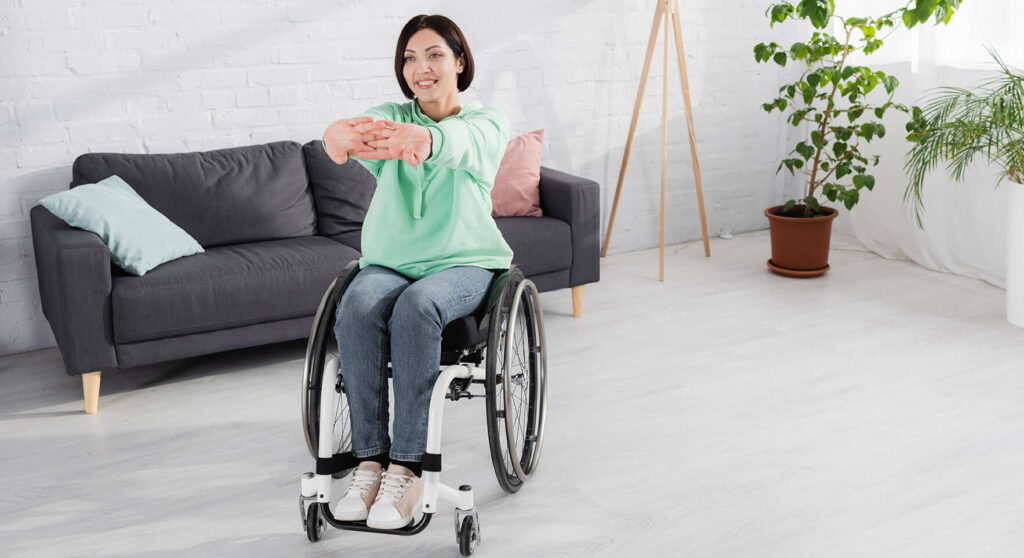Staying Active with Adaptive Yoga After SCI

Adjusting to life after a spinal cord injury is challenging, and individuals with SCIs often struggle with finding ways to stay active. But regular physical activity is crucial for staying healthy, especially if you have a spinal cord injury. Staying active after a spinal cord injury can help reduce the risk of chronic health problems such as heart disease, high blood pressure, diabetes, weight gain, chronic pain, and more.
Many individuals with SCIs have turned to adaptive yoga to stay active and help improve their overall quality of life. But like any form of exercise, it can be intimidating to get started. Join us as we go over the ins and outs of adaptive yoga and how you can incorporate it into your daily routine.
What is Adaptive Yoga?
Adaptive yoga, or accessible yoga, uses modified poses and movements that suit all body types and abilities to connect the mind, body, and spirit through a combination of physical postures, breathing, and meditation or relaxation. Adaptive yoga is perfect for individuals with spinal cord injuries, multiple sclerosis, Parkinson’s disease, or other neuromuscular conditions.
Adaptive yoga is more often personalized than regular yoga. Adaptive yoga poses are customized to suit your abilities and makes poses more accessible for wheelchair users. It can also be practiced in a smaller group setting or by yourself and paced much slower to ensure you get a feel for the movements.
Benefits of Adaptive Yoga
Adaptive yoga is healthy for both your body and your mind. Practicing adaptive yoga and meditation can lead to an improved physical and mental well-being. Many individuals find accessible yoga calming and helps get them back in sync with their bodies after their spinal cord injury.
Many individuals with SCIs have found that accessible yoga can help:
- Lower stress
- Reduce pain
- Improve quality of sleep
- Improve strength
- Improve mental health
- And more!
You can also combine accessible yoga with physical therapy. Many rehab facilities across the country have started incorporating adaptive yoga into physical therapy sessions to help improve flexibility, balance, strength, and breathing through simple poses while sitting in your wheelchair or on a mat.
How Can I Start Practicing Adaptive Yoga?
You can start incorporating adaptive yoga into your daily routine right now.
Adaptive yoga is easy to get started, as there is no special equipment needed and most poses are done in a sitting position, directly from your wheelchair. Many accessible gyms and rehab centers offer adaptive yoga classes that you can attend, but you can also complete adaptive yoga sessions from the comfort of your home. There are a variety of videos online that showcase different adaptive poses and stretches, as well as videos that will walk you through an entire adaptive yoga session.
Wheelchair-Friendly Yoga Poses
Once you’re ready to start practicing adaptive yoga, you can incorporate wheelchair-friendly yoga poses into your daily routine to help lower stress, improve mental health, and stay active with an SCI.
While you don’t need any special equipment to start practicing adaptive yoga, there are a few items that can be found around your home that can increase your overall comfort and range of motion while starting with adaptive yoga. These items may include towels, blankets, and pillows.
Seated Cat-Cow Pose
Sitting in your wheelchair, with your back away from the backrest, place your hands on your knees or the tops of your thighs. While inhaling, Inhale arch your back, and roll your shoulders down and back, making sure you bring your shoulder blades down your back (Cow Pose). While exhaling, round your spine down your chin towards your chest, letting your shoulders and head come forward (Cat Pose). Repeat for 5 breaths to help relieve back and neck tension.
Sun Salutation
Sitting upright, breathe in and lift your arms up, pressing your palms overhead. While exhaling, float your arms back down to your sides and repeat 5 times.
Upper Back Stretch
Making a circle with your arms, drop your chin down towards your chest. Push toward the opposite hand and focus on spreading your shoulder blades apart.

Shoulder Shrug
With your arms at your side, gently lift your shoulders as high up toward your ears as you can while inhaling, then slowly lower your shoulders as you breathe out. Repeat 10 times. You should feel the tension being released as you lower your shoulders.
Side Stretch
Lift one arm up over your head as you inhale, using your other arm as support. Exhale as your stretching art reaches as far as it can over your head. Hold this pose for 3 to 5 breathes, then repeat with your other arm.
Eagle Pose
Sitting upright, bring your right arm under your left arm, crossing them at the elbows with your hands back-to-back. Hold for 20 seconds as you continue breathing.
Chair Forward Bend
Sitting up straight in your wheelchair, exhale as you bend forward, extending the top half of your body over the lower half. If necessary, place your hands on your chair for support. Hold for 3-5 breaths.
Staying active after a spinal cord injury can be challenging, but it doesn’t have to be. Incorporating adaptive yoga into your daily routine is easy and can help you feel healthier and more energized throughout your day.